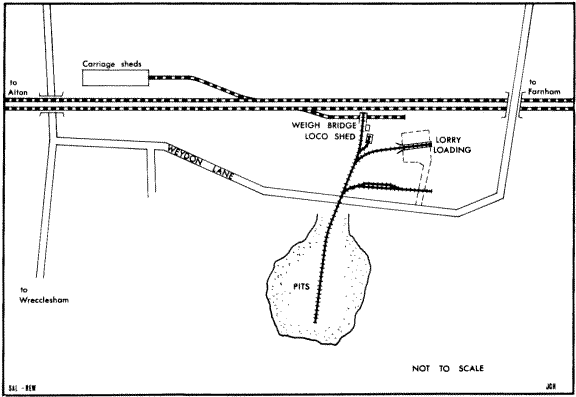
| THE INDUSTRIAL RAILWAY RECORD |
© APRIL 1968 |
WEYDON HILL SAND PITS
SYDNEY A. LELEUX
It is now about seventeen years since I last saw the railway here. I was then about ten, but as I often used to go down the road to watch the "little train", I do not think my memory will be greatly at fault.
Weydon Hill sand pit (GR 834458, sheet 169) lay to the west of Farnham, close to the Southern Railway carriage sheds. The 2ft 0in gauge railway connected a deep sand pit on the south side of Weydon Lane with loading docks for rail and road. I think the sand was dug by hand. Once I remember seeing a small dragline in the pit, but it could have been on development work.
Temporary tracks were laid on the floor of the pit from the face to the foot of the "main line". This started in the centre of the pit and climbed up out of it on a long steep embankment. The ungated level crossing over Weydon Lane gave brief respite for the locomotive, the climb continuing on the other side of the road, where the railway entered an area of waste land covered with high grass and brambles.
Immediately beyond the level crossing a pair of sidings, forming, I think, a loop were thrown off. They were very overgrown and used occasionally for wagon storage. The main line climbed on an embankment and then divided. One line continued straight and terminated on a simple wooden gantry spanning the SR siding. The other line curved away and led to a wood-and-concrete gantry beneath which lorries could be driven for loading. A short concrete road was provided for the lorries. Between the two branches was the locomotive shed, made of corrugated iron painted dark red, as was also the weighbridge hut beside the SR gantry.
The locomotive was a cabless Simplex painted black or dark green. It could just manage to push two or three loaded jubilee wagons up out of the pit. I suppose there were about a dozen wagons in use, whilst a few old bodies and frames lay rusting in the brambles beside the level crossing.
The railway closed and was dismantled a year or so after we left Farnham in 1950. In recent years the pit has been used as a refuse tip.
* * *
Another 2ft 0in gauge railway which existed in this area in the late 1940's was at the Pottery, Wrecclesham (1½ miles south-west of Farnham). Here a short hand operated line carried clay from the pit to the pottery, where it was made into chimney pots and vases. The rolling stock consisted of two or three jubilee wagons.'
